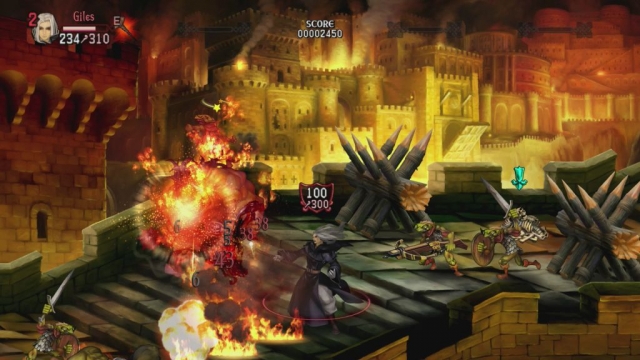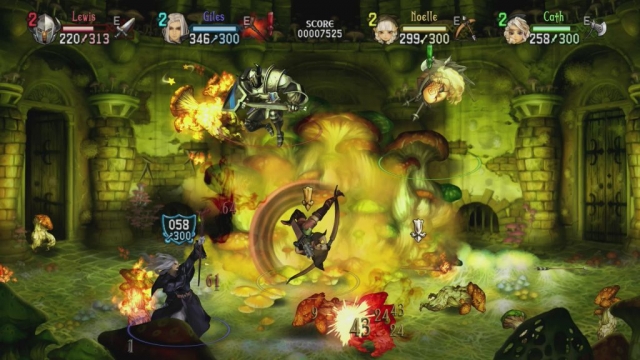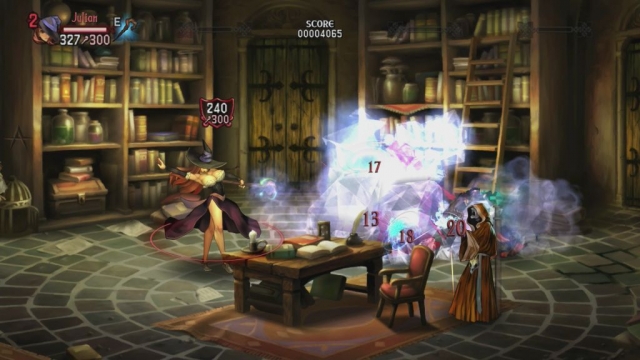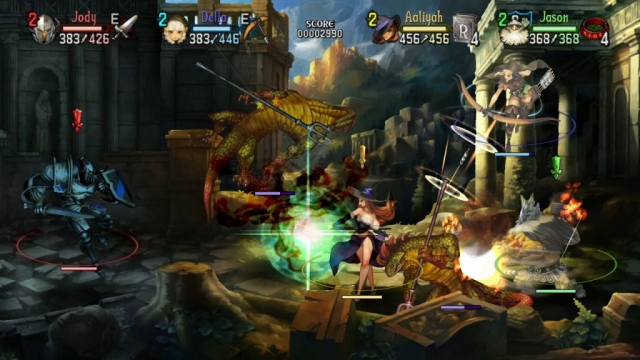Dragon’s Crown
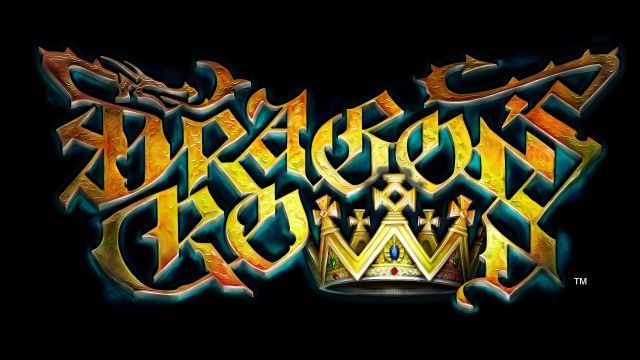
Dragon’s Crown is the best-looking brawler ever and one of the smoothest-playing. It’s been highly-anticipated for years due to both constant delays and it continuing the same kind of brawler/action RPG style as Princess Crown, Odin Sphere, and Muramasa – only with online and offline drop-in co-op and more than one plane to move in. Final Fight and Streets of Rage veterans will feel right at home with the gameplay, even if the fantasy setting is a tad odd at first.
Part of that is due to the visuals. Like Odin Sphere, character designs border on the absurd, with chests that appear to take up about 70% of their body – and that’s just a few of the male characters. With the women, that percentage seems to be a bit higher, including the in-game repair shop-runner who is somehow able to see items to fix up beneath her ample breasts. The proportions of every character are insane, but their art is simply stunning. One thing about the art design is that by going with extremes, they’re usually memorable. You’ll run into someone who appears to be an old beggar asking for a single coin and he is so skeletal that it’s both sickening and fascinating. Moreover, it’s striking and one of the defining images that comes to my mind when thinking about the game.
Others would largely involve fighting screen-filling bosses, clearing screens with the aid of monsters you can ride on ala Golden Axe. Players of that franchise will have a much easier transition to Dragon’s Crown than fans of the urban-based ones. Instead of being a bad enough dude to rescue the president, you need to be a bad enough member of a team to find the wacky McGuffin of the adventure – the Dragon’s Crown. It has vague gigantic magical powers, and results in mass corruption and backstabbing from people trying to acquire it.
The plot has more depth to it than most brawlers, but isn’t very compelling. Fortunately, it also doesn’t take much time and can be easily skipped through if you really don’t like it. I found the storyline to be a bit convoluted but commend it for trying something a bit different than the usual “town X is under siege from mysterious super criminal/group”. Normalcy isn’t an altogether bad thing though, as the inclusion of standard character types makes the game more accessible. If you’d like longer-range combat, you’ve got a few options there with wizards, elves and sorceresses. Shorter-range fighters are available along with female amazons that decide to fight massive amounts of foes in g-strings for whatever reason and dwarves that are short in stature, but can do a ton of damage by dual-wielding weapons. Close-ranger fighters can excel with combos, but leave themselves wide open for more attacks while longer-range characters do a bit less damage per attack, but are safer to use.
Smooth controls help make each character fun to play as, although you’ll probably want to at least have both a long and shorter-ranged character to assist you. Each stage pits you against wave after wave of enemies, and there’s usually an alternate path to take. Sometimes these may require a special item to get through, and then there are times when you can just summon Rannie, your helper character, to open a particular door, or the absolutely-not-Tinkerbell fairy will just point them out. The drop-in co-op is seamless and allows you to maintain a 3-4 party game when your AI partners die.
While you can beat stages on your own, you’ll want to be at least a level or two above the boss to survive, and that’s not easy to do without a lot of grinding. A little bit of grinding can help out a lot though since you can gain more piles of bones to either resurrect for new allies – sometimes at fairly high levels, or bury them and get a rare item drop that can aid you. You can get hints for what to do with each person with their death quote – if someone seems like they’re at peace, you’re more likely to get an item, but if they still clearly had some fight in them, it’s best to bring them back to kick some ass.
The gameplay experience is smooth most of the time, and the only real issue I encountered was it being a bit difficult to tell exactly where you were in relation to enemies – especially when a ton of stuff was happening at once. There’s also some occasional slowdown, but it never hinders things. If you dig grinding, then you’ll love the in-game quests, which are largely optional objectives you can complete during a stage. These can be fairly simple, like riding a beast and killing X amount of enemies, or more complex, like finding a particular hidden path through a stage to find clues to a greater mystery. They feel like the equivalent of in-game achievements since you can easily wind up doing many of these things during the course of normal gameplay, but reward you with a lot of XP and money, so they’re a bit more fun to try.
As with any brawler, repetition can creep into things a bit, and there aren’t a lot of ways to break that up beyond talking to NPCs and resurrecting or burying folks. As a result, playing it in hour-long bursts is a good idea, although you may easily wind up playing it longer online due to the increased social aspect really making games like these more fun. The core game plays largely the same between the PS3 and Vita, but does feature some fairly substantial differences that make the Vita version the best-playing. The touch screen is used absolutely perfectly here, with a mere tap being all you need to do to revive either yourself, dead party members, or have Rannie grab treasures during battle. On the PS3, these tasks can be done, but they take more time – something the real-time, unpausable gameplay doesn’t exactly afford you much of. You need to be as efficient as possible, especially when there’s a lot happening, and it’s harder to do that on the PS3.
The use of the right stick as a cursor with R3 counting as a click certainly works, but isn’t as fun to use or immersive as the touchscreen. Gathering treasure feels like a greater reward with the touch feature, while saving partners from certain death is also more rewarding with it. Trying to make use of the more advanced rune magic using the PS3 pad instead of the touch screen is a downright chore, and it’s a shame the PS3 pad doesn’t have a touchpad because without one, it really makes playing this game on a regular controller more difficult. It’s still incredibly fun, but loses something without touch controls.
The painted art style pops on the Vita’s OLED screen, but one downside to that is the screen size does prevent some finer details from being seen. While it’s a high-res screen, the game really does look best when viewed on a massive HDTV. In screenshots, the game’s beauty shines and in video form, you’ll get a sense for the anarchy that awaits you. Character animation is sometimes limited – like for running, but it works at adding in some comedy since you’ll wind up with giant, hulking fighters dashing across the screen with crazily-unrealistic strides that you can’t help but be amused by. Attack animations seem to have just enough animation to look good without being so smooth that they take a lot of time,
Musically, Dragon’s Crown’s fantasy-style songs fit the setting and also have an epic sound to them as well. The soundtrack is very well-made and is the kind of OST you’ll want to listen to on its own without any distractions and isn’t exactly the kind you’ll be humming a lot of before or after playing. The in-game narration is solid and manages to get across the drama in a stern way without crossing the line and making things comedic. It’s all played straight and works well. Beyond that, there isn’t much voice work to be found other than little quips from the characters since the storyline progresses in text boxes.
Dragon’s Crown is an outstanding brawler/action RPG hybrid. It’s got satisfying gameplay, an enjoyable storyline with some twists and turns that are surprising, unbelievable graphics, and an epic soundtrack too. The game is a must-own for Vita owners that is still quite good on PS3, but is hurt by the touch screen controls working so perfectly on the go. Sadly, the game isn’t a cross-buy title, so since buying both versions is out of the question for most, I’ll have to recommend the Vita version. Ninety-nine times out of 100, I’d recommend a console version over a portable version, but here, all you’re losing out on is some image quality and you’re gaining the ability to control the game easier and save $10 in the process since it’s $40 instead of $50.
Reviewed By: Jeremy Peeples
Publisher: Atlus
Rating: 85%
——————————————————————————–
This review is based on a digital copy of Dragon’s Crown for the PlayStation 3 provided by Atlus.
PlayStation Vita Screens
PlayStation 3 Screens
 Game Over Online
Game Over Online